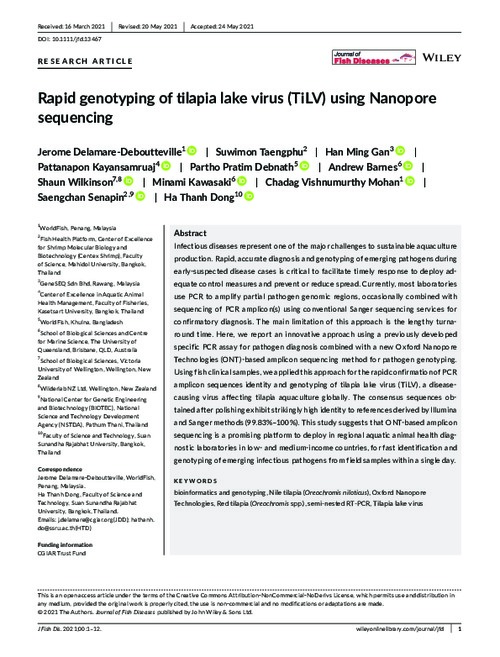Rapid genotyping of tilapia lake virus (TiLV) using Nanopore sequencing

Infectious diseases represent one of the major challenges to sustainable aquaculture production. Rapid, accurate diagnosis and genotyping of emerging pathogens during early-suspected disease cases is critical to facilitate timely response to deploy adequate control measures and prevent or reduce spread. Currently, most laboratories use PCR to amplify partial pathogen genomic regions, occasionally combined with sequencing of PCR amplicon(s) using conventional Sanger sequencing services for confirmatory diagnosis. The main limitation of this approach is the lengthy turnaround time. Here, we report an innovative approach using a previously developed specific PCR assay for pathogen diagnosis combined with a new Oxford Nanopore Technologies (ONT)-based amplicon sequencing method for pathogen genotyping. Using fish clinical samples, we applied this approach for the rapid confirmation of PCR amplicon sequences identity and genotyping of tilapia lake virus (TiLV), a disease-causing virus affecting tilapia aquaculture globally. The consensus sequences obtained after polishing exhibit strikingly high identity to references derived by Illumina and Sanger methods (99.83%–100%). This study suggests that ONT-based amplicon sequencing is a promising platform to deploy in regional aquatic animal health diagnostic laboratories in low-and medium-income countries, for fast identification and genotyping of emerging infectious pathogens from field samples within a single day.
Permalink
Date Available
Type
Publisher
ISSN
0140-7775,1365-2761
Copyright
CC-BY-NC-ND-4.0
Research Themes
Topics
Language